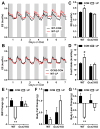Metabolic Responses to Dietary Protein Restriction Require an Increase in FGF21 that Is Delayed by the Absence of GCN2
- PMID: 27396336
- PMCID: PMC4956501
- DOI: 10.1016/j.celrep.2016.06.044
Metabolic Responses to Dietary Protein Restriction Require an Increase in FGF21 that Is Delayed by the Absence of GCN2
Abstract
FGF21 contributes to the metabolic response to dietary protein restriction, and prior data implicate GCN2 as the amino acid sensor linking protein restriction to FGF21 induction. Here, we demonstrate the persistent and essential role of FGF21 in the metabolic response to protein restriction. We show that Fgf21 KO mice are fully resistant to low protein (LP)-induced changes in food intake, energy expenditure (EE), body weight gain, and metabolic gene expression for 6 months. Gcn2 KO mice recapitulate this phenotype, but LP-induced effects on food intake, EE, and body weight subsequently begin to appear after 14 days on diet. We show that this delayed emergence of LP-induced metabolic effects in Gcn2 KO mice coincides with a delayed but progressive increase of hepatic Fgf21 expression and blood FGF21 concentrations over time. These data indicate that FGF21 is essential for the metabolic response to protein restriction but that GCN2 is only transiently required for LP-induced FGF21.
Copyright © 2016 The Author(s). Published by Elsevier Inc. All rights reserved.
Conflict of interest statement
The authors have declared that no conflict of interest exists.
Figures






References
-
- Anthony TG, McDaniel BJ, Byerley RL, McGrath BC, Cavener DR, McNurlan MA, Wek RC. Preservation of liver protein synthesis during dietary leucine deprivation occurs at the expense of skeletal muscle mass in mice deleted for eIF2 kinase GCN2. J Biol Chem. 2004;279:36553–36561. - PubMed
-
- Badman MK, Pissios P, Kennedy AR, Koukos G, Flier JS, Maratos-Flier E. Hepatic fibroblast growth factor 21 is regulated by PPARalpha and is a key mediator of hepatic lipid metabolism in ketotic states. Cell Metab. 2007;5:426–437. - PubMed
MeSH terms
Substances
Grants and funding
LinkOut - more resources
Full Text Sources
Other Literature Sources
Medical
Molecular Biology Databases
Research Materials

